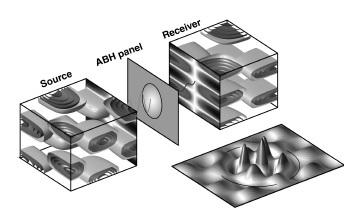In areas like aeronautics, underwater vehicles and civil transportation, among others, reducing structural vibration and sound pressure level is a challenging task. In re- cent years, the concept of acoustic black holes (ABHs) in mechanics has been proposed to this aim and attract the attention of the vibroacoustics research community. ABHs usually consist of geometrical indentations on beams and plates having a power-law decreasing thickness profile. An ABH slows down the phase and group velocity of inci- dent flexural waves in such a way that, ideally, it would take an infinite amount of time for them to reach the ABH center, if the latter had an exact zero thickness. Though this is not possible in practice, strong wave dissipation can be achieved by placing a damp- ing layer at the central region of the ABH, where most vibration energy concentrates. In recent years, ABHs have been not only exploited as a passive means for structural vibration and noise reduction, but its potential for other applications like wave manip- ulation or energy harvesting have been also explored.
The objective of this thesis is threefold. Therefore, after an initial overview the work is divided into three main parts. The first one deals with ABH applications on straight beams and flat plates. To start with, an ABH piezoelectric bimorph cantilever for en- ergy harvesting that circumvents the shortening wavelength problem at the ABH tip is proposed and analyzed. Then, ring-shaped ABH indentations are suggested as a means of isolating external excitation points in flat plates and prevent vibration trans- mission. Finally, periodic ABH array configurations are contemplated to collimate flex- ural wave beams and focus energy at desired plate locations. The second part of the thesis proposes new ABH designs for curved structures. The latter are very common in the naval, aeronautical and industrial sectors so it is worth investigating if ABHs could function for them. The section starts analyzing the embedding of ABHs on circular beams and shows how this results in the appearance of typical phenomena of periodic systems. After that, an annular ABH is proposed to reduce vibrations in cylindrical shells. The cases of a simply supported shell with an annular ABH indentation and of a periodic simply supported ABH shell with stiffeners are considered. Attention is paid to some unexpected ABH behavior. To finish the section, the effects of annular ABHs on sound radiation are investigated in terms of sound power level, radiation ef- ficiency and supersonic intensity, showing great improvement as compared to those of a uniform cylindrical shell. The third part of the thesis is shorter than the previous ones and is devoted to analyzing the transmission loss of a plate with multiple ABH inden- tations, in the mid-high frequency range. Statistical modal energy distribution analysis is used for that purpose. Here, the ABH plate is not taken as an individual structure but coupled to two air cavities, thus being part of a more complex mechanical system. Throughout the thesis repeated use is made of the Gaussian expansion method (GEM). The GEM refers to taking Gaussian functions as the basis for solving par- tial differential equations in the framework of the Rayleigh-Ritz method. The GEM closely resembles wavelet approaches but offers some advantages in the case of peri- odic boundary conditions. A brief overview of the GEM is exposed at the beginning of the thesis and, when necessary, its reformulation for a particular problem is tackled in its corresponding chapter.
